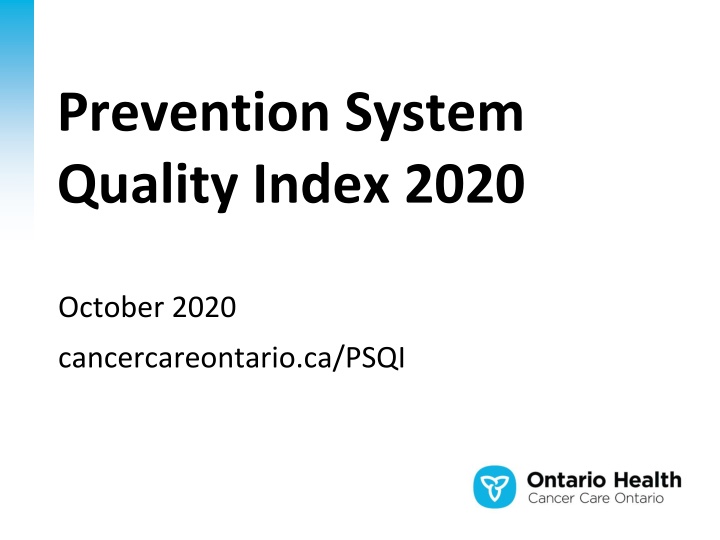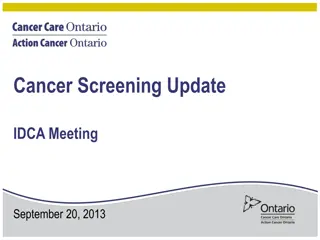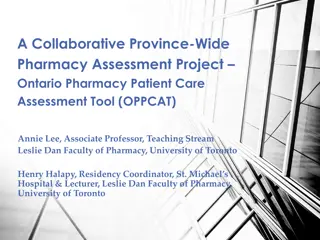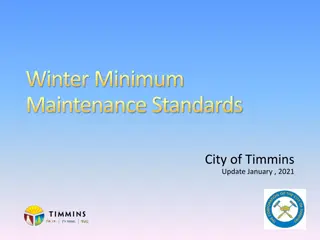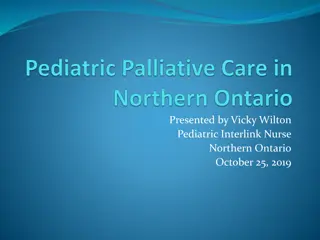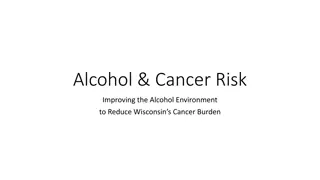Cancer Prevention System Quality Index 2020: Addressing Cancer Risk Factors in Ontario
The Prevention System Quality Index 2020 from CancerCareOntario provides a detailed report on indicators, policies, and programs to address cancer risk factors in Ontario. It offers evidence and data to aid in the implementation of effective cancer prevention measures by various agencies. The report highlights cancer risk factors, exposure domains, and recommendations, such as increasing tobacco taxes to align with World Health Organization guidelines. Detailed data on tobacco taxes across provinces and territories in 2018 are also presented as part of the report.
Download Presentation

Please find below an Image/Link to download the presentation.
The content on the website is provided AS IS for your information and personal use only. It may not be sold, licensed, or shared on other websites without obtaining consent from the author.If you encounter any issues during the download, it is possible that the publisher has removed the file from their server.
You are allowed to download the files provided on this website for personal or commercial use, subject to the condition that they are used lawfully. All files are the property of their respective owners.
The content on the website is provided AS IS for your information and personal use only. It may not be sold, licensed, or shared on other websites without obtaining consent from the author.
E N D
Presentation Transcript
Prevention System Quality Index 2020 October 2020 cancercareontario.ca/PSQI
Prevention System Quality Index Background Report on indicators of system-level policies and programs to address cancer risk factors Provides evidence and data to help governments, nongovernmental organizations and local public health agencies implement cancer prevention policies and programs in Ontario 1
Prevention System Quality Index 2020 Cancer risk factor and exposure domains in the 2020 report: Developed with guidance from an Advisory Committee and Expert Panel Report, Highlights, Supplementary Tables, Technical Appendix and Slideshow are available at cancercareontario.ca/PSQI 2
Prevention System Quality Index 2020 Chapter structure Risk factor or exposure link to cancers Burden of risk factor (prevalence, attributable cancers, economic costs) Review of effective policies and programs with indicators of implementation in Ontario where data are available Opportunities to reduce risk factor or exposure in Ontario What s new o Brief highlight of cancer prevention in Indigenous populations 3
Tobacco smoking (1) Tobacco taxation The World Health Organization recommends that tobacco taxes make up 75% or more of the total retail price of tobacco. In 2018, taxes made up 65.3% of the average total retail price of cigarettes in Ontario. Opportunity: Increase tobacco taxes to at least 75% of the retail price. 4
Tobacco taxes as a percentage of average total retail price per carton of 200 cigarettes, by province or territory, 2018 Province or territory Pre-tax price ($) Total taxes ($) Average total retail price ($) Tax as a percentage of total retail price (%) British Columbia 36.31 92.67 128.97 71.9 Manitoba 40.74 98.92 139.66 70.8 Nova Scotia 41.66 96.97 138.64 69.9 Saskatchewan 39.79 90.79 130.58 69.5 Quebec 29.28 66.07 95.35 69.3 Newfoundland and Labrador 39.79 89.75 129.53 69.3 Prince Edward Island 42.08 91.24 133.32 68.4 New Brunswick 45.60 92.96 138.56 67.1 Ontario 39.20 73.80 113.01 65.3 Alberta 43.52 79.72 123.24 64.7 Yukon 49.68 90.53 140.21 64.6 Nunavut 54.42 90.76 145.18 62.5 Northwest Territories 57.73 91.77 149.50 61.4 5
Tobacco smoking (2) Second-hand smoke exposure There is no safe level of second-hand smoke exposure. Smoke- free laws and policies protect people from second-hand smoke. In 2015 2016, 14.6% of adults and 29.7% of adolescents reported exposure to second hand smoke every day or almost every day in public places in the past month. Opportunity: Increase awareness and enforcement of the Smoke-Free Ontario Act and promote broader implementation of smoke-free policies. 6
Tobacco smoking (3) Smoke-free policies in social housing People who live in multi-unit housing (in particular, social housing) may be more likely to be exposed to second-hand smoke than people who live in single detached homes. As of January 2020, 8 out of 13 social housing providers with 1,500 or more residential units had a smoke-free policy, providing protection for about 96,600 out of 225,200 residents. Opportunity: Increase smoke-free policies in social and other multi-unit housing. 7
Smoke-free policies in local housing corporations with 1,500 or more residential units, Ontario, 2020 Local housing corporation (approximate number of units) Approximate number of residents Has the local housing corporation implemented a smoke-free policy for all properties? Toronto Community Housing Corporation (60,000) 110,000 No Yes: Ottawa Community Housing No-Smoking Policy. Effective May 31, 2014. Ottawa Community Housing Corporation (15,000) 32,000 Yes: Peel Living Smoke-Free Living Policy. Effective November 1, 2018. Peel Living (6,900) 15,600 Yes: CityHousing Hamilton Corporation Smoke-Free Living Policy. Effective January 1, 2020. CityHousing Hamilton (7,100) 14,000 Windsor Essex Community Housing Corporation (4,700) Yes: Smoke-free policy Windsor Essex Community Housing Corporation. Effective January 1, 2018. 12,000 Yes: Waterloo Region Housing Smoke-Free Policy. Effective April 1, 2010. Waterloo Region Housing (2,720) 11,800 London & Middlesex Community Housing (3,280) 5,000 No Niagara Regional Housing (2,840) 5,000 No Yes: The District of Thunder Bay Social Services Administration Board Housing Services Smoke-Free Policy. Effective September 1, 2015. The District of Thunder Bay Social Services Administration Board (2,480) 5,000 Greater Sudbury Housing Corporation (1,850) 4,500 No Halton Community Housing Corporation (2,190) 4,100 No Yes: Smoke-Free Policy for Housing York Inc. Effective November 1, 2014. Housing York Inc. (2,600) 4,000 Yes: Simcoe County Housing Corporation Non- Smoking Policy. Effective November 13, 2018. Simcoe County Housing Corporation (1,600) 2,200 8
Tobacco smoking (4) Smoking cessation A provincial-level focus on increasing the number of smokers who try to quit, and their number of quit attempts, may help increase the smoking cessation rate. In 2017, 48.1% of adult smokers made 1 or more quit attempts in the past 12 months. During 2015 2017, 51.5% of adults reporting past daily or occasional smoking, quit smoking completely at least 1 year ago. Opportunity: Increase mass media campaigns to support quit attempts and expand funding for smoking cessation programs to ensure free access to counselling supports and pharmacotherapy. 9
Percentage of adults (age 20+) reporting past daily or occasional smoking, who stopped smoking completely at least 1 year ago, by public health unit, Ontario, 2015 2017 combined Ontario Algoma Brant County Chatham-Kent Durham Region Eastern Ontario Elgin-St. Thomas Grey Bruce Haldimand-Norfolk Haliburton, Kawartha, Pine Ridge District Halton Region Hamilton Hastings and Prince Edward Counties Huron County Kingston, Frontenac and Lennox & Addington Lambton Leeds, Grenville and Lanark District Middlesex-London Niagara Region North Bay Parry Sound District Northwestern Ottawa Oxford County Peel Perth District Peterborough County-City Porcupine Region of Waterloo Renfrew County and District Simcoe Muskoka District Sudbury and District Thunder Bay District Timiskaming Toronto Wellington-Dufferin-Guelph Windsor-Essex County York Region 0 10 20 30 40 50 60 70 80 90 100 10 Percent (%)
Alcohol (1) Minimum price of alcohol To achieve substantial reductions in drinking in Ontario, it is estimated that the minimum price for alcohol sold in retail stores should be $1.75 per standard drink (2019 dollars). As of March 2019, the minimum prices per standard drink for alcohol sold in retail stores ranged from $1.06 for beer to $1.55 for spirits. Opportunity: Increase the minimum price of alcohol sold in retail stores to $1.75 per standard drink (2019 dollars). 11
Alcohol (2) Alcohol availability Privatization of alcohol retail stores and increasing the number of alcohol retail stores faster than the growth of a population in a given area may result in increased alcohol drinking. In 2019, 79.3% of alcohol retail stores were privately owned, which was an increase from 75.9% in 2015. In 2019, there were 2.5 alcohol retail stores for every 10,000 people ages 15 and older compared to 2.3 in 2015. Opportunity: Identify an appropriate limit for privatized alcohol retail stores and the number of alcohol retail stores based on the size of the population. 12
Number of alcohol retail stores per 10,000 people (age 15+), by public health unit, Ontario, January 2019 Ontario Algoma Brant County Chatham-Kent Durham Region Eastern Ontario Elgin-St. Thomas Grey Bruce Haldimand-Norfolk Haliburton, Kawartha, Pine Ridge District Halton Region Hamilton Hastings and Prince Edward Counties Huron County Kingston, Frontenac and Lennox & Addington Lambton Leeds, Grenville and Lanark District Middlesex-London Niagara Region North Bay Parry Sound District Northwestern Ottawa Oxford County Peel Perth District Peterborough County-City Porcupine Region of Waterloo Renfrew County and District Simcoe Muskoka District Sudbury and District Thunder Bay District Timiskaming Toronto Wellington-Dufferin-Guelph Windsor-Essex County York Region 0.0 1.0 2.0 3.0 Number per 10,000 4.0 5.0 6.0 7.0 8.0 13
Healthy eating (1) Household food insecurity Food insecurity reduces a household s ability to afford adequate food. Households with the lowest income are much more likely to experience food insecurity than households with the highest income. In 2017, 15.0% of households experienced some level of food insecurity. Opportunity: Implement provincial poverty reduction policies, including increasing the minimum wage and income supports to reduce household food insecurity. 14
Percentage of households that were food insecure in the past year, overall (marginal, moderate and severe combined), by level of food insecurity and by sex, Ontario, 2017 30 Ontario Males Females 25 20 Percent (%) 15 10 5 0 Overall Marginal Moderate Severe 15
Healthy eating (2) Food literacy development in secondary schools Food literacy development in schools including learning how to choose and prepare healthy foods can increase healthy eating among children and youth, shaping lifelong health. From 2005/06 to 2012/13, only about 1/3 of students who started Grade 9 in each of these school years completed 1 or more credits that included food literacy during their secondary school education. Opportunity: Include at least 1 required credit that has a food literacy component as part of the Ontario secondary school curriculum. 16
Physical activity (1) Active transportation in adults and adolescents People who regularly walk, bicycle or use other forms of active transportation report higher levels of overall physical activity. In 2015 2017, 48.0% of adults and 78.7% of adolescents ages 12 to 17 reported using active transportation in the past week. Opportunity: Continue to develop provincial and municipal infrastructure, policies and plans that support active transportation. 17
Percentage of adults (age 18+) who reported use of active transportation in the previous week, by public health unit, 2015 2017 combined Ontario Algoma Brant County Durham Region Elgin-St. Thomas Grey Bruce Haldimand-Norfolk Haliburton, Kawartha, Pine Ridge District Halton Region Hamilton Hastings and Prince Edward Counties Huron County Chatham-Kent Kingston, Frontenac and Lennox & Addington Lambton Leeds, Grenville and Lanark District Middlesex-London Niagara Region North Bay Parry Sound District Northwestern Ottawa Oxford County Peel Perth District Peterborough County-City Porcupine Renfrew County and District Eastern Ontario Simcoe Muskoka District Sudbury and District Thunder Bay District Timiskaming Toronto Region of Waterloo Wellington-Dufferin-Guelph Windsor-Essex County York Region 0 10 20 30 40 Percent (%) 50 60 70 80 90 100 18
Percentage of adolescents (ages 12 to 17) who reported use of active transportation in the previous week, by frequency of use and by public health unit, 2015 2017 combined Ontario Algoma Brant County Durham Region Elgin-St. Thomas Grey Bruce Haldimand-Norfolk Haliburton, Kawartha, Pine Ridge District Halton Region Hamilton Hastings and Prince Edward Counties Huron County Chatham-Kent Kingston, Frontenac and Lennox & Addington Lambton Leeds, Grenville and Lanark District Middlesex-London Niagara Region North Bay Parry Sound District Northwestern Ottawa Oxford County Peel Perth District Peterborough County-City Porcupine Renfrew County and District Eastern Ontario Simcoe Muskoka District Sudbury and District Thunder Bay District Timiskaming Toronto Region of Waterloo Wellington-Dufferin-Guelph Windsor-Essex County York Region 0 10 20 30 40 50 60 70 80 90 100 Percent (%) 19
Physical activity (2) Health and physical education specialist teachers in schools Physical education specialists can improve the quality of physical education classes and increase the time students spend being physically active during class time. In the 2016/17 school year, 21.7% of elementary schools and 20.3% of secondary schools reported having at least 1 health and physical education specialist teacher. Opportunity: Increase the percentage of schools that have a health and physical education specialist teacher. 20
Percentage of publicly funded elementary and secondary schools in Ontario with at least 1 full or part-time specialist teacher assigned to teach health and physical education, 2006/07 to 2016/17 school years 50 40 Percent (%) 30 20 10 0 2006/07 2007/08 2008/09 2009/10 2010/11 2011/12 2012/13 2013/14 2014/15 2015/16 2016/17 Elementary, full time Elementary, part time Secondary, full time Secondary, part time 21
Physical activity (3) Enrolment in health and physical education courses Physical education classes can increase overall physical activity in children and adolescents and address a decrease in physical activity that occurs during adolescence. In the 2016/17 school year, 86.3% of students in Grade 9 took a health and physical education course credit, compared to 28.2% of students in Grade 12. Opportunity: Require health and physical education credits in every grade of secondary school. 22
Ultraviolet radiation (1) Shade policies Built structures and dense tree canopies can provide shade and protect people from UVR exposure more reliably than sunscreen. As of 2019, 3 local municipalities with a population of 100,000 or more have strong shade policies in their planning policy documents, which state that shade should be provided for a broad range of sites. The number of municipalities with a strong shade policy is unchanged from 2016. From 2016 to 2019, 5 local municipalities added moderate shade policies to their planning policy documents, which state that shade should be provided for a few types of sites. Opportunity: Strengthen municipal shade policies, and monitor the implementation and impact of these policies. 23
Strength of shade policies in the planning policy documents of local municipalities in Ontario with populations of 100,000 or more, 2016 and 2019 *Shade policy of the municipality improved from limited to moderate since the 2016 review. **Shade policy of the municipality was not previously included and improved to moderate since the 2016 review. 24
Ultraviolet radiation (2) Tanning bed use in Ontario students in Grade 7 to 12 In 2014, the Ontario government enacted the Skin Cancer Prevention Act (Tanning Beds) to ban the sale and marketing of tanning services to youth under age 18. The results of a survey conducted 1 year after the Skin Cancer Prevention Act came into effect showed no changes in tanning bed use for students in Grades 7 to 12 compared to the results of a similar survey conducted before the act came into effect (7.9% in 2015 vs 6.9% in 2014). Opportunity: Monitor tanning bed use in youth and increase enforcement of the Skin Cancer Prevention Act (Tanning Beds). 25
Environmental carcinogens PM2.5 concentrations in outdoor air Fine particulate matter (PM2.5) in outdoor air pollution increases the risk of lung cancer. There is no known safe level of exposure to PM2.5. In 2017, annual average PM2.5 concentrations ranged from 4.1 to 8.5 g/m3 at monitoring stations in Ontario. All average PM2.5 concentrations were lower than the current Canadian Ambient Air Quality Standard of 8.8 g/m3. Opportunity: Continue to reduce emissions from homes, the transportation sector and industrial facilities. 26
Annual average ambient fine particulate matter (PM2.5) concentrations ( g/m3) in Ontario, by monitoring station, 2013 to 2017 Monitoring station 2013 2014 2015 2016 2017 Monitoring station 2013 2014 2015 2016 2017 Oakville 8.0 8.5 8.3 7.0 6.9 Barrie 7.5 7.6 7.6 6.5 7.0 Oshawa 7.4 7.7 7.5 5.9 5.9 Belleville 6.9 6.8 6.6 5.5 5.8 Ottawa Central 7.1 6.8 6.9 5.6 5.8 Brampton 8.5 8.9 8.4 6.8 7.0 Ottawa Downtown 7.0 7.0 6.9 5.9 5.9 Brantford 8.5 9.2 8.7 7.3 7.2 Parry Sound 5.8 5.8 5.7 4.8 4.6 Burlington 8.7 9.6 9.4 7.6 7.0 Petawawa 4.8 4.7 4.8 4.4 4.1 Chatham 8.1 8.6 8.1 6.6 6.4 Peterborough 7.4 6.9 6.8 5.8 5.8 Cornwall 7.7 7.0 6.9 6.4 5.9 Port Stanley 7.4 8.2 8.0 6.5 6.3 Dorset 5.4 5.3 5.6 4.6 4.6 Sarnia 8.5 9.0 8.4 INS 7.0 Grand Bend 7.3 8.1 7.7 6.0 5.1 Sault Ste. Marie 5.6 6.0 5.9 4.9 5.0 Guelph 8.1 8.9 8.4 6.9 6.8 St. Catharines 8.5 8.8 8.4 6.9 7.0 Hamilton Downtown 10.1 10.8 10.2 8.2 8.5 Sudbury 5.7 6.0 6.3 5.4 5.0 Hamilton Mountain 9.2 9.4 9.0 7.2 7.4 Thunder Bay 6.3 6.6 6.5 5.8 5.1 Hamilton West 9.6 9.9 9.9 7.9 7.5 Tiverton 5.8 6.5 6.4 5.1 5.1 Kingston 6.5 6.8 6.3 5.8 5.3 Toronto Downtown 8.3 8.7 8.4 7.0 7.4 Kitchener 8.7 9.3 8.8 7.3 7.0 Toronto East 8.2 8.9 8.5 7.0 7.4 Toronto North 8.3 9.2 9.4 7.3 7.4 London 9.1 8.8 8.3 7.1 7.0 Toronto West 8.8 9.1 8.5 7.0 7.4 Mississauga 7.9 8.7 8.5 7.2 6.8 Windsor Downtown 9.2 10.1 9.3 8.1 7.8 Morrisburg 6.7 7.0 N/A N/A N/A Windsor West 10.0 10.7 9.9 8.5 8.5 Newmarket 7.3 7.3 7.1 6.0 5.9 North Bay 5.2 5.3 5.3 4.6 4.6 27 Bolded values exceed 8.8 g/m3, the PM2.5 reference level set by the Canadian Ambient Air Quality Standards, effective in 2020.
Occupational carcinogens (1) Industrial nickel use Nickel compounds are a known cause of lung, nasal and sinus cancers. Nickel compounds are commonly found in fumes from welding. The number of facilities that reported using nickel to the Toxics Reduction Program and the total amount of nickel used decreased from 2013 to 2016. However, the total number of employees working at industrial facilities that reported using nickel increased during this same time period. Opportunity: Introduce ventilation requirements in Ontario Occupational Health and Safety legislation for welding activities. 28
Amount of nickel used (in tonnes) and number of employees working at facilities using nickel in Ontario, 2013 to 2016 Year Use (tonnes) Number of employees Number of facilities 2013 869,915 40,890 131 2014 870,027 40,889 125 2015 869,235 43,358 125 2016 864,027 44,147 123 29
Occupational carcinogens (2) Industrial formaldehyde use Formaldehyde exposure can cause cancer of the nasopharynx and leukemia, and may be a cause of sinus cancer. The amount of formaldehyde use reported in Ontario was lower in 2016 than in the previous 3 years. The number of employees and the number of facilities reporting formaldehyde use were about the same from 2013 to 2016. Opportunity: Reduce the ceiling limit for formaldehyde to 0.3 parts per million, as recommended by the Canadian Labour Code and the American Conference of Governmental Industrial Hygienists. 30
Amount of formaldehyde used (in tonnes) and number of employees working at facilities using formaldehyde in Ontario, 2013 to 2016 Year Use (tonnes) Number of employees Number of facilities 2013 10,330 28,544 32 2014 20,246 30,382 29 2015 18,897 29,242 31 2016 9,054 30,925 32 31
Infectious agents School-based human papillomavirus (HPV) and hepatitis B vaccination coverage Publicly funded school-based vaccination programs for HPV and the hepatitis B virus are offered to students in Grade 7 in Ontario. At the end of the 2017/18 school year: o 59.9% of 12-year-old children received two doses of the HPV vaccine through the school-based program. o 69.2% of 12-year-old children received two doses of the hepatitis B vaccine through the school-based program. Opportunity: Support local public health agencies in increasing education for parents and students on the benefits and safety of vaccinations. 32
Up-to-date human papillomavirus vaccination coverage (%) in 12-year-old students in Ontario, by public health unit, 2017/18 school year Ontario Algoma Brant County Chatham-Kent Durham Region Eastern Ontario Elgin-St. Thomas Grey Bruce Haldimand-Norfolk Haliburton, Kawartha, Pine Ridge District Halton Region Hamilton Hastings and Prince Edward Counties Huron County Kingston, Frontenac and Lennox & Addington Lambton Leeds, Grenville and Lanark District Middlesex-London Niagara Region North Bay Parry Sound District Northwestern Ottawa Oxford County Peel Perth District Peterborough County-City Porcupine Renfrew County and District Simcoe Muskoka District Sudbury and District Thunder Bay District Timiskaming Toronto Region of Waterloo Wellington-Dufferin-Guelph Windsor-Essex County York Region 0 10 20 30 40 50 60 70 80 90 100 33 Percent (%)
Prevention System Quality Index Website and contact cancercareontario.ca/PSQI Contact: Maria Chu, Prevention System Quality Index Lead cancerprevention@ontariohealth.ca 34
